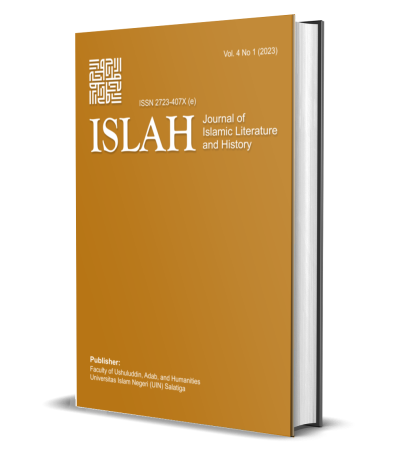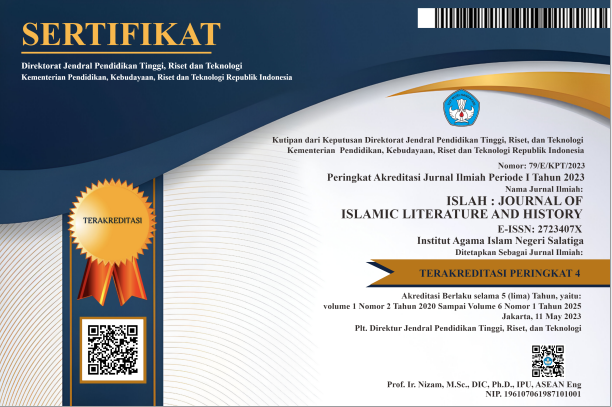Shahbandar and Waliyah: Islamic Female Leadership in Gresik (11th-15th Centuries)
DOI:
https://doi.org/10.18326/islah.v6i1.4243Keywords:
leadership, women, Islam, GresikAbstract
This study aims to analyze two models of female leadership in Islam in Gresik during the formative period (11th -15th centuries) by comparing Siti Fatimah binti Maimun (d. 1082 CE) and Nyai Ageng Pinatih (active 1458-1477 CE). Employing microhistory and feminist historiography methodologies, the research reveals two distinct forms of authority: spiritual genealogical leadership (Waliyah) and structural-maternal leadership (Shahbandar). Siti Fatimah established her authority through Islamic genealogy and religious scholarship, reflected in her monumental tomb complex. Meanwhile, Nyai Ageng Pinatih utilized administrative competence and political networks as the shahbandar (port master) of Gresik port. The findings demonstrate the flexibility of the Nusantara Islamic social system in accommodating female leadership through diverse legitimation mechanisms, challenging the religious-secular authority dichotomy. Moreover, the research also reveals the disparity in collective memory between the two figures, reflecting gender bias in Indonesian Islamic historiography. In conclusion, this study contributes to understanding the complexity of female leadership traditions in Indonesian Islam and its relevance to contemporary gender debates.
References
ABU‐LUGHOD, LILA. “The Romance of Resistance: Tracing Transformations of Power through Bedouin Women.” American Ethnologist 17, no. 1 (1990). https://doi.org/10.1525/ae.1990.17.1.02a00030.
Azra, Azyumardi. Historiografi Islam Kontemporer: Wacana, Aktualitas Dan Aktor Sejarah. Jakarta: Gramedia Pustaka Utama, 2013.
Blackburn, Susan. Women and the State in Modern Indonesia. Women and the State in Modern Indonesia, 2004. https://doi.org/10.1017/CBO9780511492198.
Brewer, Rose M., and Patricia Hill Collins. “Black Feminist Thought: Knowledge, Consciousness, and the Politics of Empowerment.” Contemporary Sociology 21, no. 1 (1992). https://doi.org/10.2307/2074808.
Butler, Judith. “Selection From Gender Trouble: Feminism and the Subversion of Identity.” In The Transgender Studies Reader Remix, 2022. https://doi.org/10.4324/9781003206255-21.
Chaudhuri, K. N. Trade and Civilisation in the Indian Ocean: An Economic History from the Rise of Islam to 1750. Trade and Civilisation in the Indian Ocean: An Economic History from the Rise of Islam to 1750, 2014. https://doi.org/10.1017/CBO9781107049918.
Decobert, Christian, and Richard W. Bulliet. “Conversion to Islam in the Medieval Period, an Essay in Quantitative History.” Studia Islamica, no. 58 (1983). https://doi.org/10.2307/1595346.
Fraser, Nancy. “Rethinking the Public Sphere: A Contribution to the Critique of Actually Existing Democracy.” In Public Space Reader, 2021. https://doi.org/10.4324/9781351202558-6.
Ginzburg, Carlo. Clues, Myths, and the Historical Method. Clues, Myths, and the Historical Method, 2023. https://doi.org/10.56021/9780801834585.
Gottschalk, Louis R. “Understanding History, A Primer of Historical Method.” Nursing Research 2, no. 1 (1953). https://doi.org/10.1097/00006199-195306000-00021.
Graaf, H.J. de, and G. Th. Pigeaud. “Chinese Muslims in Java in the 15th and 16th Centuries: The Malay Annals of Semarang and Cerbon.” Monash Papers on Southeast Asia, no. 12 (1984).
Hall, Kenneth R. Maritime Trade and State Development in Early Southeast Asia. Maritime Trade and State Development in Early Southeast Asia, 2019. https://doi.org/10.2307/j.ctv9zckps.
Hodgson, Marshall GS. The Venture of Islam, Conscience and History in a World Civilization , The Classical Age of Islam, Vol. 1. Chicago and London, 1974.
Keane, Webb, and Nancy K. Florida. “Writing the Past, Inscribing the Future: History as Prophecy in Colonial Java.” Anthropological Quarterly 70, no. 1 (1997). https://doi.org/10.2307/3317804.
Lombard, Denys. “Nusa Jawa: Silang Budaya.” Sejarah, 2005.
Mahmood, Saba. Politics of Piety: The Islamic Revival and the Feminist Subject. Politics of Piety: The Islamic Revival and the Feminist Subject, 2011. https://doi.org/10.1525/aa.2006.108.3.603.
McNeill, William H., and Charles Tilly. “Big Structures, Large Processes, Huge Comparisons.” Journal of Interdisciplinary History 17, no. 2 (1986). https://doi.org/10.2307/204777.
Ortner, Sherry B. “Is Female to Male as Nature Is to Culture?” In Feminism, The Public And The Private, 2023. https://doi.org/10.1093/oso/9780198752035.003.0002.
Peletz, Michael G. Reason and Passion: Representations of Gender in a Malay Society. Reason and Passion: Representations of Gender in a Malay Society, 2023. https://doi.org/10.2307/2761066.
Proudfoot, I. “Early Malay Printed Books.” Reading, 1993.
Ptak, Roderich. “Die Maritime Seidenstraße.” In China Und Asiens Maritime Achse Im Mittelalter, 2019. https://doi.org/10.1515/9783110626353-003.
Ramusack, Barbara N.., and Sharon L.. Sievers. “Women in Asia : Restoring Women to History,” 1999.
Reid, Anthony. Southeast Asia in the Age of Commerce, 1450-1680. Southeast Asia in the Age of Commerce, 1450-1680, 2017. https://doi.org/10.12987/9780300159455.
Ricklefs, M. C. Islamisation and Its Opponents in Java: A Political, Social, Cultural and Religious History, c. 1930 to the Present. Islamisation and Its Opponents in Java: A Political, Social, Cultural and Religious History, c. 1930 to the Present, 2012.
———. Mystic Synthesis in Java: A History of Islamization from the Fourteenth to the Early Nineteenth Centuries. EastBridge, a Nonprofit Corporation. Vol. 1, 2006.
Rosaldo, Michele Z. “Woman, Culture and Society: A Theoretical Overview.” Woman, Culture and Society, 1974.
Scott, Joan W. “Gender: A Useful Category of Historical Analysis.” In Theory and Method in Women’s History, 2012. https://doi.org/10.7312/scot91266-004.
Sears, Laurie J., and Benedict Anderson. “Imagined Communities: Reflections on the Origin and Spread of Nationalism.” Journal of the American Oriental Society 114, no. 1 (1994). https://doi.org/10.2307/604991.
Skocpol, Theda. “Vision and Method in Historical Sociology.” Labour / Le Travail 17 (1986). https://doi.org/10.2307/25142663.
Turner, Bryan S., and Talal Asad. “Genealogies of Religion: Discipline and Reasons of Power in Christianity and Islam.” Sociology of Religion 55, no. 3 (1994). https://doi.org/10.2307/3712068.
Whitmore, John K. “Southeast Asia The Flaming Womb: Repositioning Women in Early Modern Southeast Asia, By Barbara Watson Andaya, Honolulu: University of Hawaii Press, 2006. Pp. 335. Maps, Notes, Bibliography, Index.” Journal of Southeast Asian Studies 38, no. 3 (2007). https://doi.org/10.1017/s002246340700029x.
Woodward, Mark. Java, Indonesia and Islam. Java, Indonesia and Islam, 2011. https://doi.org/10.1007/978-94-007-0056-7.
Zamakhsyari Dhofier. Tradisi Pesantren (Studi Tentang Pandangan Hidup Kiai). Jakarta: LP3ES, 1982.
Downloads
Published
Issue
Section
License
Copyright (c) 2025 Abdul Karim Wirawan, Ulfa Rosyidah

This work is licensed under a Creative Commons Attribution-ShareAlike 4.0 International License.
Copyright
Authors retain copyright and grant the journal right of first publication with the work simultaneously licensed under a Creative Commons Attribution-ShareAlike 4.0 International License. In line with the license, authors are allowed to share and adapt the material. In addition, the material must be given appropriate credit, provided with a link to the license, and indicated if changes were made. If authors remix, transform or build upon the material, authors must distribute their contributions under the same license as the original.
Licensing

This work is licensed under a Creative Commons Attribution-ShareAlike 4.0 International License.








